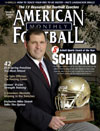AMERICAN FOOTBALL MONTHLY THE #1 RESOURCE FOR FOOTBALL COACHES
Article CategoriesAFM Magazine
|
The Strength Report© More from this issueI have had the opportunity to be a strength and conditioning coach for 11 years, and had the privilege of working in some great programs with some great head coaches. From Oklahoma, to Minnesota, to Kansas, I have been fortunate enough to work with many great athletes and had the opportunity to learn quite a bit about how to develop not only sport specific strength, but also position specific strength. Philosophy / Strategy The game of football is ever-evolving; however. one element that has not changed is the fact that the game is still played below the waist and above the neck. When I refer to “above the neck,” I am referring to how smart a player is, which quite often comes down to film study, and on the field practice. My primary focus as a strength coach is to help with the “below the waist.” I want to ma....The full article can only be seen by subscribers. Subscribe today!
|
|
|||||||
| HOME |
MAGAZINE |
SUBSCRIBE | ONLINE COLUMNISTS | COACHING VIDEOS |
Copyright 2025, AmericanFootballMonthly.com
All Rights Reserved





